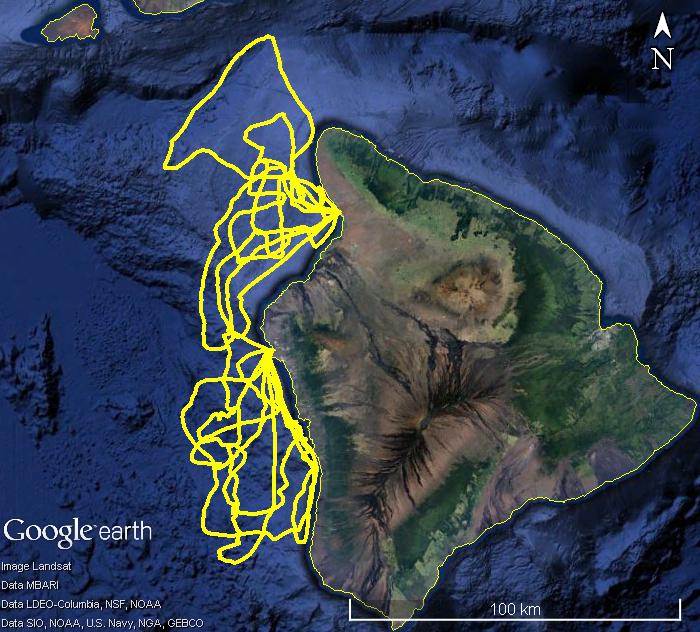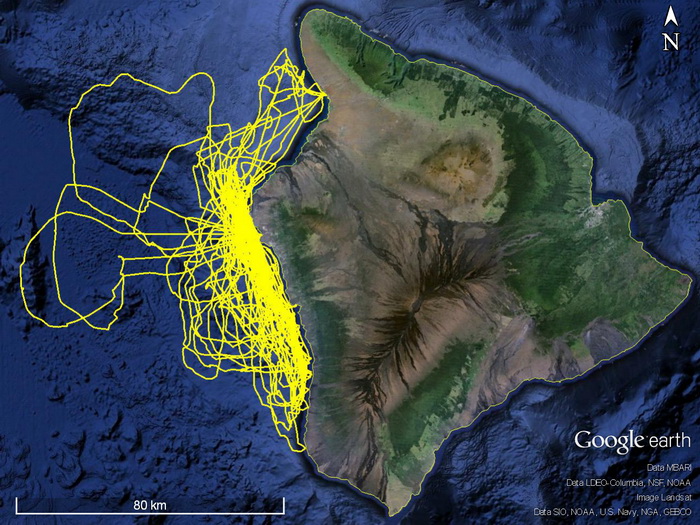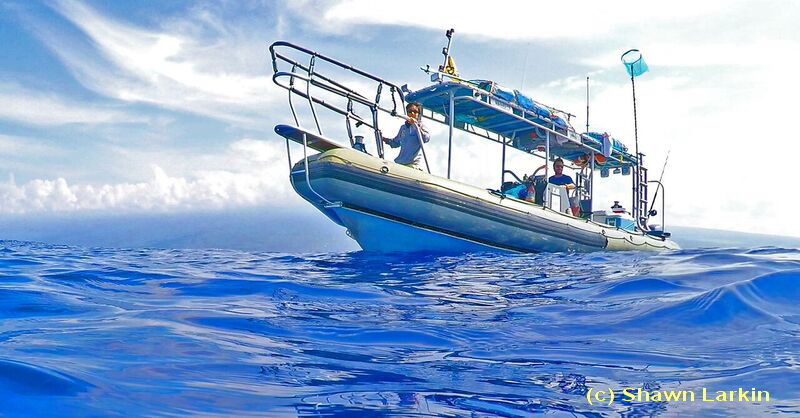We will be undertaking a 12-day field project based out of Kawaihae, Hawai‘i Island starting July 18, 2016. This will be our third field effort in Hawai‘i and our first off Hawai‘i Island this year, and our 15th year of working off the island of Hawai‘i. Basing out of Kawaihae, rather than our normal operations based out of Honokohau, will allow us to spend most of our time much farther north off the island than typical, in an area where we expect to have higher sighting rates of both false killer whales and melon-headed whales. Our primary goals for the field effort are to find these two species, photo-identify as many individuals of each as possible, and deploy LIMPET satellite tags, although like all of our field projects though, we will work with all species of whales and dolphins we encounter. We will also be collecting remote skin/blubber biopsy samples for genetics, toxicology and hormone chemistry, picking up any squid we find to determine what types of prey are in the area, and photo-identifying as many individuals of all species as possible (we have photo-ID catalogs of 11 different species in Hawai‘i).
This project is supported by several sources, including the Pacific Islands Fisheries Science Center, Bycatch Reduction Engineering Program of NOAA Fisheries, the Office of Naval Research, and Dolphin Quest.
The research crew for this project will include Daniel Webster, Annie Douglas, Kim Wood, Colin Cornforth and Robin Baird, as well as a number of volunteers.
We had a short (7-day) field project based out of Kawaihae last year that was quite productive – to find out what we saw and did on that project check out our update page for that project. If you want some background information on our work in Hawai‘i we published a paper on our first 13 years of surveys and a pdf is available here
End of project update
Over the last 12 days we spent 10 days on the water, covered over 1,600 km of trackline off the island, had 33 encounters with 12 species of cetaceans, took over 27,000 photos for individual identification, to document injuries and to identify petrels and other seabirds, collected one squid, and 14 biopsy samples for genetics, toxicology and hormone chemistry. Overall a very good trip.

A newborn short-finned pilot whale next to it’s mother. If you look closely, you can see the hair follicles on the upper jaw (the four raised bumps). The mother has a bite wound from a fairly large shark on her back just in front of her dorsal fin, quite unusual for a pilot whale in Hawai‘i. Photo (c) Annie B. Douglas

Another view of the newborn pilot whale – you can see how lumpy this individual is – these are fat folds, reflecting that the calf has been doing well nursing. Photo (c) Colin J. Cornforth. For more information on pilot whales in Hawai‘i check out our short-finned pilot whale page

Our survey effort this trip – working both out of Kawaihae and Honokohau harbors we were able to survey a broad area off the west coast of the island.

As on all of our trips, we document migratory seabirds, like this Juan Fernandez Petrel seen July 28, 2016. Photo (c) Robin W. Baird. For more information on seabirds in Hawai‘i check out our seabird page

A very distinctive rough-toothed dolphin, July 29, 2016. Photo (c) Daniel L. Webster. For more information on rough-toothed dolphins in Hawai‘i check out our web page for that species
July 26th update

We’ve worked out of Kawaihae the last couple of days, and had relatively low sighting rates, with just a few sightings of spotted, spinner and bottlenose dolphins. These bottlnenose dolphins were seen to the north of the Kona airport, July 26, 2016. Photo (c) Kimberly A. Wood.

There is a small resident population of bottlenose dolphins off the island, and we were able to get good identification photos of most of the individuals encountered. Photo (c) Colin J. Cornforth

We also encountered a group of spinner dolphins, and obtained photos that we’ll contribute to a catalog at the Pacific Islands Fisheries Science Center. Photo (c) Annie B. Douglas

An adult male spinner dolphin, based on the very upright dorsal fin. This individual has a fairly fresh bite wound from a cookie-cutter shark on the middle of the back, as well as some scar tissue below the base of the dorsal fin, that may have been caused from damage from a remora, which often attach at the base of the fin. Photo (c) Daniel L. Webster
July 23rd update
Tropical storm Darby continues to influence our plans, but we were able to work off the Kona coast again today, and encountered a group of six Blainville’s beaked whales, our 11th species for the trip.

The group included three mother/calf pairs, and we were able to get good identification photos of all six individuals. Blainville’s beaked whales acquire white oval scars from cookie-cutter shark bites throughout their lives, and we used these scars to identify individuals. Photo (c) Annie B. Douglas

We were able to match all three of the adult females to our catalog – all are part of the resident island-associated population. This individual, HIMd036 in our catalog, was first identified off the island in 2002, and seen again in 2008, 2011, 2012, 2015 and 2015. Photo (c) Kimberly A. Wood
One of the juveniles was very curious about our boat – this footage was taken with a GoPro over the side of the vessel. Footage (c) Seth Conae
July 21st update
With winds continuing to pick up in advance of tropical storm Darby, today we launched out of Honokohau and worked off the Kona coast. We ended up seeing seven different species of odontocetes today, including three new species for the trip, but the highlight was obvious – a group of five killer whales.

This is only our 4th ever sighting of killer whales in Hawaiian waters, since this project first started in 2000. Killer whales in Hawaii are part of a tropical open-ocean population, thought to range widely across the central Pacific. We have a small photo-identification catalog of killer whales and will compare the photos obtained to see if there are any matches. Photo (c) Kimberly A. Wood.

We were working in coordination with the NOAA R/V Oscar Elton Sette today, and they were able to deploy two satellite tags on individuals in the group, so we should be able to monitor their movements over the coming weeks. Photo (c) Daniel L. Webster

For more information on killer whales in Hawai‘i see our web page for this species. Photo (c) Annie B. Douglas

We also encountered a group of striped dolphins, an open-ocean species typically found only in deep waters around the islands. Photo (c) Robin W. Baird
July 20th update

Today the winds picked up so we weren’t able to get as far north as we have the last two days, but we did encounter our fifth species of odontocete for the trip, a group of about 180 pantropical spotted dolphins. The group contained several newborn individuals, with faint fetal folds visible along their sides. Photo (c) Robin W. Baird

This map shows our trackline from the last three days.
July 19th update
Today the winds picked up so we weren’t able to get as far north as we have the last two days, but we did encounter our fifth species of odontocete for the trip, a group of about 180 pantropical spotted dolphins.

A dwarf sperm whale and the HMAS Canberra, July 19, 2016. The HMAS Canberra is the flagship of the Royal Australian Navy, operating in the area as part of RIMPAC. Dwarf sperm whales are one of the species of cetaceans known to be susceptible to impacts from naval sonars, although it is unknown whether tactical naval sonars are being used in the area. Photo (c) Robin W. Baird

We had three groups of dwarf sperm whales today, and were able to get good identification photos of three individuals, including this distinctive one, with a hole through the trailing edge of the fin likely caused by a cookie-cutter shark bite. There is a resident, island-associated population of dwarf sperm whales off the island, so we’ll compare these photos to our catalog to see if any of them match individuals from the island-associated population. Photo (c) Colin J. Cornforth

We also encountered another group of short-finned pilot whales and were able to get good identification photos of about half the individuals present. This photo shows an adult male pilot whale spyhopping. Photo (c) Kimberly A Wood.

An oceanic whitetip shark, following the pilot whales. Oceanic whitetips often follow pilot whales, feeding on feces and scraps of food that pilot whales leave behind. Photo (c) Robin W. Baird
July 18th update

Today was a rare calm day in the ‘Alenuihāhā, the channel between Maui and Hawai‘i Island, and we were able to survey to within 15 km of Maui (see map below). Although sighting conditions were excellent, we found only a single group of rough-toothed dolphins in the channel. We were able to get good identification photos of all the individuals present. Photo (c) Colin J. Cornforth/Cascadia Research.

This map shows our trackline from today, covering ~190 km.

We also encountered a small group of short-finned pilot whales, were able to get identification photos of six individuals, and collected three biopsy samples for genetic studies as well as examination of stress hormones. Photo (c) Kimberly A. Wood/Cascadia Research.

A pilot whale with a naval vessel in the background, part of the RIMPAC exercise. Photo (c) Annie B. Douglas/Cascadia Research

We’ve previously worked off the island in July in 2006, 2008, 2010, and 2014 – this map shows all of our previous effort here in the month of July, a total of 68 days on the water.

The vessel we’ll be using for this project, the Bella Rain. Photo (c) Shawn Larkin.
All photos are copyrighted and should not be used without permission (contact Robin Baird at rwbaird (at) cascadiaresearch.org for permission).
Like us on Facebook page if you want to receive notices of when information is posted and updates on other Cascadia projects.
Check out reports on previous Hawai‘i field projects
Return to the Cascadia Research Hawai‘i web page